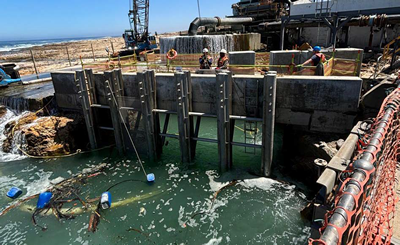- Perspective – November 2025
- Sassda News – State of the Stainless Steel Nation Breakfast
- GPS Round Up
- State of the Stainless Steel Nation
- Sassda News
- Professional Profile – Lourens Kloppers
- Member News – Duva Chemicals
- Case Study – Grandi Manufacturing
- Global Metals Advert
- Case Study – Electropolishing
- NDE Advert
- Country Profile – Ethiopia
- Member News – BeztForex
- Sassda News – Energy Storage Summit Africa
- Sassda News – Gauteng Sports Day
Grandi Manufacturing’s 13-tonne stainless steel sea water filter for Tronox Namakwa Sands

In 2024, Grandi Manufacturing completed one of South Africa’s largest stainless steel fabrications, a 13-tonne Sea Water Filter built for Tronox Namakwa Sands on South Africa’s West Coast. Designed to operate in one of the most corrosive coastal environments in Southern Africa, the project demonstrates local expertise in precision stainless-steel fabrication and corrosion-resistant engineering.
Project overview
Located near Brand-se-Baai, the Tronox Namakwa Sands operation extracts and processes heavy mineral sands for global markets. A key part of this process is the Slurry Transfer Facilities (STFs) structures that dewater mineral slurry while recovering process water. The Sea Water Filter forms part of this system, enabling the controlled transfer and filtration of saline water.
The project ran over several months, from design through fabrication, inspection, and delivery. All work took place at Grandi Manufacturing’s Cape Town facility under the supervision of International Welding Engineer Robert Lawrence. The structure comprised several sub-assemblies including large-diameter piping, complex joints, and a ten metre stainless-steel beam, all built to tight tolerances and supported by full documentation and testing.
Purpose and material selection
The aim was to fabricate a durable, corrosion-resistant filter able to withstand abrasive mineral slurry and the saline coastal climate. Permanently exposed to saltwater and fine particulates, stainless steel offered the only material capable of delivering the required strength and longevity.
Grade 316L stainless steel was chosen for its proven marine performance and low-carbon composition, which prevents sensitisation and intergranular corrosion essential for welded assemblies in chloride-rich conditions. Its mechanical stability also allowed the structure to handle dynamic loads while maintaining alignment and minimal distortion.
Fabrication detail
All components were laser-cut from 316L plate to control distortion and ensure dimensional accuracy. Plate thickness ranged from 5.5 mm to 10 mm depending on load.
Key elements included:
- Main piping, 275 mm diameter x 10 mm wall x 5 m, extended to 7 m through precision joining.
- A 316L box beam, 400 mm x 400 mm x 5.5 mm, spanning ten metres as the main structural element.
All welding used 316L filler wire with Acral Chrome shielding gas, and welders were qualified to AWS D1.6 Stainless Steel Structural Code. Welding parameters, inter-pass temperatures, and bead geometry were logged in a detailed data pack for traceability.
After welding, all surfaces were pickled and passivated to restore the chromium-rich film essential for corrosion resistance and prepare the surface for long-term coastal exposure.
Engineering challenges and solutions
The project’s complexity lay in its scale, precision, and the behaviour of stainless steel under heat. Joining the extruded 316L pipe sections proved difficult due to ovality. Grandi’s engineers, led by Owner and Managing Director Marco Grandi and Partner Brandon Ryneveld, developed a custom jigging system to ensure accurate alignment during welding.
Fabricating the ten-metre box beam to strict tolerances presented another challenge. To prevent distortion, the team developed a plug-welding procedure combined with backstepping short, alternating welds that balanced heat input and stress. The result was exceptional: the beam remained perfectly straight with no measurable distortion after welding.
Comprehensive Dye Penetrant Testing (DPT) was carried out on all critical welds, with 10 percent of remaining joints tested for verification. The project achieved full compliance with internal and client standards.
Sustainability and performance
From an environmental and operational standpoint, the Sea Water Filter highlights the sustainability of stainless steel in coastal industry. Its role to separate, recover, and recycle water from Tronox’s mineral slurry supports the operation’s water-conservation goals. In a region where freshwater is scarce, reclaiming and reusing process water is vital.
Stainless steel’s durability, corrosion resistance, and recyclability ensure decades of service with minimal maintenance. Its use lowers lifecycle costs and environmental impact, removing the need for coatings or frequent replacement proof of its long-term value.
Industry impact and lessons
For South Africa’s stainless steel sector, this project marks a milestone in both scale and quality. It shows that local manufacturers have the expertise and infrastructure to deliver complex, high-tolerance stainless structures to international standards.
Key lessons include:
- The importance of distortion control and heat management in large stainless assemblies.
- The value of early collaboration between design, welding, and inspection teams.
- The need for detailed welding documentation to ensure traceability and client confidence.
As Robert Lawrence, the overseeing welding engineer, notes: “This fabrication set a new benchmark for stainless steel construction in South Africa. Achieving zero distortion across ten metres of stainless while maintaining full code compliance reflects the exceptional skill and teamwork."
Conclusion
The Tronox Sea Water Filter is more than a technical success it is a showcase of South African engineering and the enduring value of stainless steel in demanding industrial environments.
Through precise fabrication, disciplined welding, and rigorous quality control, the delivered structure met its purpose and reflects the strength, sustainability, and innovation of the stainless-steel industry. Marco Grandi, concludes, “This project reflects everything we stand for, namely a precision, collaboration, and a commitment to quality. It’s a proud moment not only for our team but for South African manufacturing as a whole.”

